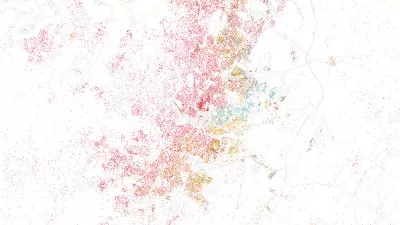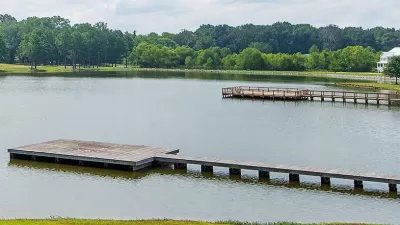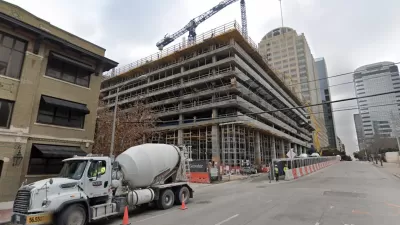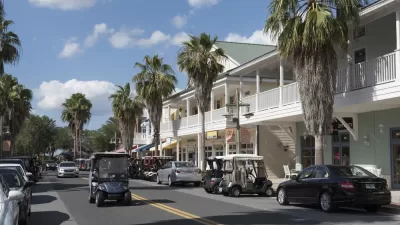In two parts, NPR's City Project examines Austin's premier mixed-use urban village built on the 700-acre site of the former Robert Mueller Municipal Airport which relocated in 1999. Part 2 is about racial tensions that have surfaced in the community.

"Mueller is an award-winning master planned and designed community, [built] in accordance with new urbanist principles," according to its website. And it has won a lot of awards, from protected bike lanes to sustainability to landscape architecture.
Construction began in Austin's "new urbanist enclave," as John Burnett, NPR's southwest correspondent, refers to it, in 2007. In Part 1, and archived in NPR Cities Project, Burnett does an excellent job of describing the design of the mixed-income, mixed-use community.
"But what happens when one of Austin's most progressive, welcoming neighborhoods experiences racial incidents involving some of its own African-American residents who don't feel so welcome?" he asks.
Burnett describes several incidents that showed that residents were suspicious of the presence of African Americans in the community, who turned out to be residents. The close-knit community, helped by the physical design of the community itself, recognized there was a problem and acted.
Taken together, the incidents convinced some Mueller residents that they needed to open a frank dialogue about race in their community. Two neighborhood meetings have followed. NPR was invited to the latest one, in early December.
"By and large, there was a collective sense of both outrage, shock and honest, sincere sadness," says James Nortey, 28, a black attorney in Austin and president of the Mueller Neighborhood Association.
A broader issue is the state of race relations in the state's capital, Austin, population 885,400. "A University of Texas report on U.S. Census data reveals that Austin is the only large, fast-growing city in America with a declining black population," writes Burnett.
From 2000 to 2010, Austin's general population jumped 20 percent, but the number of African-Americans shrank by 5 percent. Among the reasons given in the study: high property taxes, bad relations with police and disparities in public schools.
That's not to say that Austin is not completely lacking in racially diversity. Although Austin-Round Rock was rated #30 by the US2010 Project at Brown University, according to The Wall Street Journal (and posted here in Sept., 2012), the Hispanic share of its population was 31.4 percent.
Burnett ends his piece on an optimistic note. Referencing the racial strife that has erupted due after the Ferguson, Mo., shooting last August and the resulting calls for a national dialog on race, he writes that in Mueller, "that conversation is already quietly taking place."
FULL STORY: A Texas Community Takes On Racial Tensions Once Hidden Under The Surface

Trump Administration Could Effectively End Housing Voucher Program
Federal officials are eyeing major cuts to the Section 8 program that helps millions of low-income households pay rent.

Planetizen Federal Action Tracker
A weekly monitor of how Trump’s orders and actions are impacting planners and planning in America.

The 120 Year Old Tiny Home Villages That Sheltered San Francisco’s Earthquake Refugees
More than a century ago, San Francisco mobilized to house thousands of residents displaced by the 1906 earthquake. Could their strategy offer a model for the present?

HSR Reaches Key Settlement in Northern California City
The state’s high-speed rail authority reached an agreement with Millbrae, a key city on the train’s proposed route to San Francisco.

Washington State Legislature Passes Parking Reform Bill
A bill that would limit parking requirements for new developments is headed to the governor’s desk.

Missouri Law Would Ban Protections for Housing Voucher Users
A state law seeks to overturn source-of-income discrimination bans passed by several Missouri cities.
Urban Design for Planners 1: Software Tools
This six-course series explores essential urban design concepts using open source software and equips planners with the tools they need to participate fully in the urban design process.
Planning for Universal Design
Learn the tools for implementing Universal Design in planning regulations.
Ada County Highway District
Clanton & Associates, Inc.
Jessamine County Fiscal Court
Institute for Housing and Urban Development Studies (IHS)
City of Grandview
Harvard GSD Executive Education
Toledo-Lucas County Plan Commissions
Salt Lake City
NYU Wagner Graduate School of Public Service





























